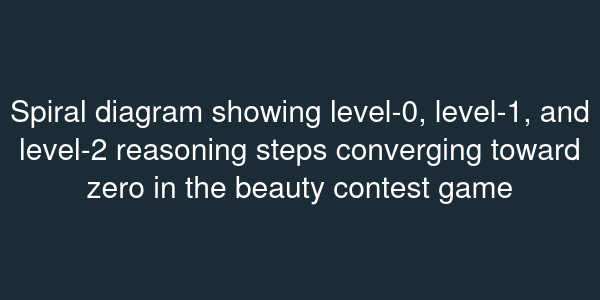Level-k Thinking
Essential Questions
- What is level-k reasoning and how does it differ from Nash equilibrium?
- How do experiments like the beauty contest reveal depth of thought?
- How can firms anticipate bounded rationality in strategic settings?
Overview
Consider a firm setting prices in a new market. Competitors may not all anticipate each other's moves perfectly. Level-k models capture this bounded rationality by assuming some players use simple heuristics while others best respond to them.
This lesson walks through the beauty contest game, introduces cognitive hierarchy models, and explores applications to auctions, pricing, and policy design.
Beauty Contest Game
Players choose a number between 0 and 100. The winner is closest to two-thirds of the average. Level-0 players pick randomly (say 50). Level-1 players choose two-thirds of 50 = 33. Level-2 players choose two-thirds of 33 ≈ 22, and so on. Nash equilibrium predicts 0, but experiments typically find averages around 20–30 in first rounds, decreasing with repetition as players learn.

Modeling Level-k
Level-k models formalize reasoning depth. Let denote players who best respond to beliefs. Suppose payoffs are . A level-k player chooses maximizing given that others are level . Cognitive hierarchy extends this by assuming a distribution of levels, often Poisson with mean . The probability of a level- player is . Players best respond to the distribution of lower-level types, not a single level.
In auctions, level-k bidders shade bids differently. Crawford and Iriberri showed that level-1 bidders in first-price auctions bid as if opponents bid their values, while level-2 bidders anticipate this and shade more. These predictions match experimental bid data better than Nash equilibrium.
Applications
In marketing, firms launching products anticipate that consumers may only compare prices within a small set, akin to level-1 reasoning. Policymakers designing congestion pricing assume drivers adjust gradually, mirroring cognitive hierarchies. In security, level-k models guide strategic disclosure policies where attackers might be level-0 (random) or level-1 (best responding to predicted defenses).
Understanding level-k thinking helps you model realistic strategic behavior. By estimating the distribution of reasoning levels in your context, you can design strategies that perform well against boundedly rational opponents.